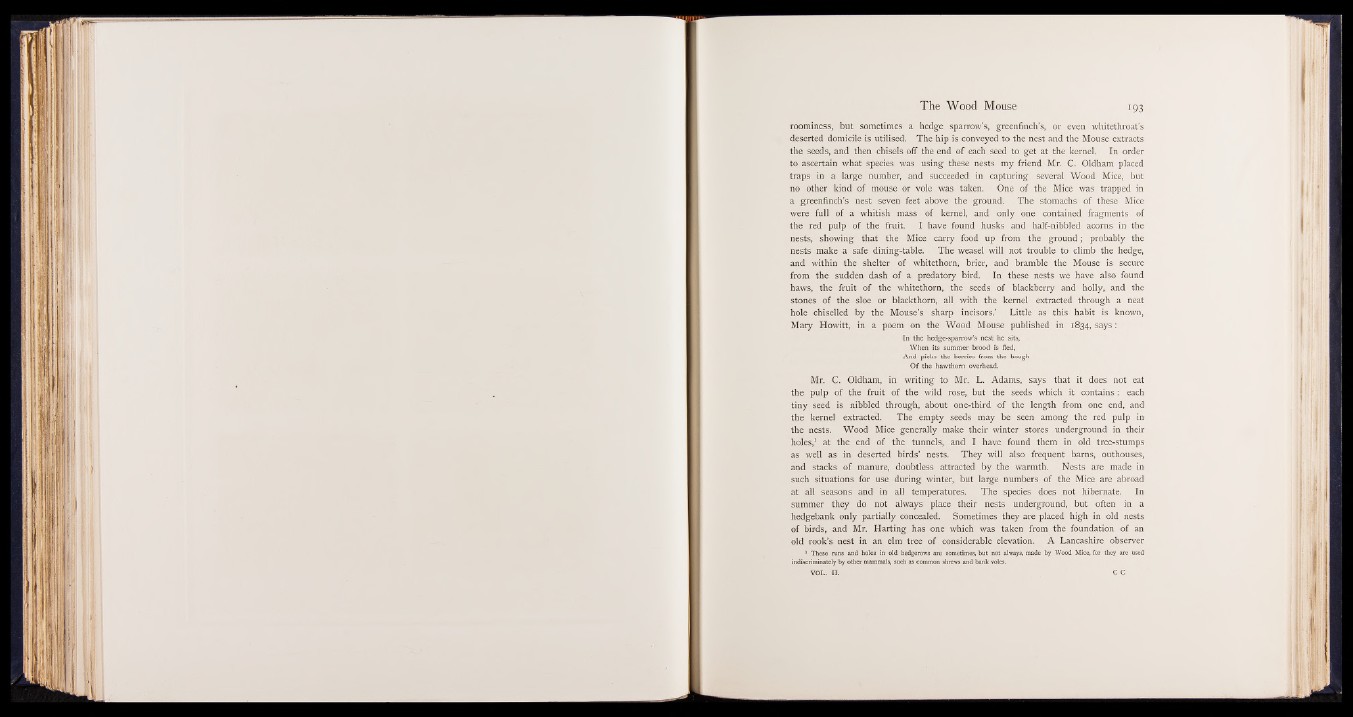
roominess, but sometimes a hedge sparrow’s, greenfinch’s, or even whitethroat’s
deserted domicile is utilised. The hip is conveyed to the nest and the Mouse extracts
the seeds, and then chisels off the end of each seed to get at the kernel. In order
to ascertain what species was using these nests my friend Mr. C. Oldham placed
traps in a large number, and Succeeded in capturing several Wood Mice, but
no other kind of mouse or vole was taken. One of the Mice was trapped in
a greenfinch’s nest seven feet above the ground. The stomachs of these Mice
were full of a whitish mass of kernel, and only one contained fragments of
the red pulp of the fruit. I have found husks and half-nibbled acorns in the
nests, showing that the Mice carry food up from the ground; probably the
nests make a safe dining-table. The weasel will not trouble to climb the hedge,
and within the shelter of whitethorn, brier, and bramble the Mouse is secure
from the sudden dash of a predatory bird. In these nests we have also found
haws, the fruit of the whitethorn, the seeds of blackberry and holly, and the
stones of the sloe or blackthorn, all with the kernel extracted through a neat
hole chiselled by the Mouse’s sharp incisors.’ Little as this habit is known,
Mary Howitt, in a poem on the Wood Mouse published in 1834, sa y s :
In the hedge-sparrow’s nest he sits,
When its summer brood is fled,
And picks the berries from the bough
Of the hawthorn overhead.
Mr. C. Oldham, in writing to Mr. L. Adams, says that it does not eat
the pulp of the fruit of the wild rose, but the seeds which it contains: each
tiny seed is nibbled through, about one-third of the length from one end, and
the kernel extracted. The empty seeds may be seen among the red pulp in
the nests. Wood Mice generally make their winter stores underground in their
holes,1 at the end of the tunnels, and I have found them in old tree-stumps
as well as in deserted birds’ nests. They will also frequent barns, outhouses,
and stacks of manure, doubtless attracted by the warmth. Nests are made in
such situations for use during winter, but large numbers of the Mice are abroad
at all seasons and in all temperatures. The species does not hibernate. In
summer they do not always place their nests underground, but often in a
hedgebank only partially concealed. Sometimes they are placed high in old nests
of birds, and Mr. Harting has one which was taken from the foundation of an
old rook’s nest in an elm tree of considerable elevation. A Lancashire observer
1 These runs and holes in old hedgerows are sometimes, but not always, made by Wood Mice, for they are used
indiscriminately by other mammals, such as common shrews and bank voles.
VOL. II. C C